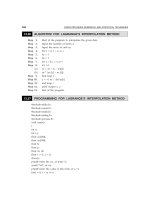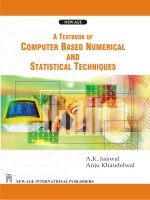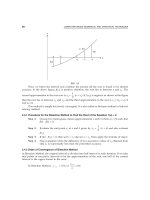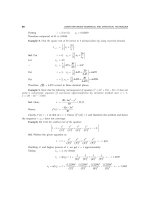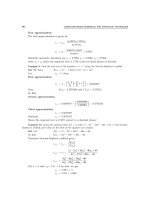- Trang chủ >>
- Khoa Học Tự Nhiên >>
- Vật lý
A textbook of fluid mechanics and
Bạn đang xem bản rút gọn của tài liệu. Xem và tải ngay bản đầy đủ của tài liệu tại đây (19.34 MB, 1,570 trang )
Downloaded From : www.EasyEngineering.net
A TEXTBOOK OF
FLUID MECHANICS
AND
ww
HYDRAULIC MACHINES
w.E
in
SI UNITS
asy
En
gin
ee
rin
g.n
et
www.pdfgrip.com
Downloaded From : www.EasyEngineering.net
Downloaded From : www.EasyEngineering.net
ww
w.E
asy
En
gin
ee
rin
g.n
et
www.pdfgrip.com
Downloaded From : www.EasyEngineering.net
Downloaded From : www.EasyEngineering.net
MULTICOLOUR EDITION
A TEXTBOOK OF
FLUID MECHANICS
AND
HYDRAULIC MACHINES
ww
w.E
asy
En
gin
eer
ing
.ne
t
in
SI UNITS
Er. R.K. RAJPUT
M.E. (Hons.), Gold Medallist; Grad. (Mech.Engg. & Elect. Engg.); M.I.E. (India);
M.S.E.S.I.; M.I.S.T.E.; C.E. (India)
Recipient of:
‘‘Best Teacher (Academic) Award’’
‘‘Distinguished Author Award’’
“Jawahar Lal Nehru Memorial Gold Medal’’
for an outstanding research paper
(Institution of Engineers–India)
Principal (Formerly):
Thapar Polytechnic College;
Punjab College of Information Technology,
PATIALA
S. CHAND & COMPANY LTD.
(AN ISO 9001 : 2008 COMPANY)
RAM NAGAR, NEW DELHI-110 055
www.pdfgrip.com
Downloaded From : www.EasyEngineering.net
Downloaded From : www.EasyEngineering.net
S. CHAND & COMPANY LTD.
(An ISO 9001 : 2008 Company)
Head Office: 7361, RAM NAGAR, NEW DELHI - 110 055
Phone: 23672080-81-82, 9899107446, 9911310888
Fax: 91-11-23677446
Shop at: schandgroup.com; e-mail:
Branches :
AHMEDABAD
: 1st Floor, Heritage, Near Gujarat Vidhyapeeth, Ashram Road, Ahmedabad - 380 014,
Ph: 27541965, 27542369,
BENGALURU : No. 6, Ahuja Chambers, 1st Cross, Kumara Krupa Road, Bengaluru - 560 001,
Ph: 22268048, 22354008,
BHOPAL
: Bajaj Tower, Plot No. 243, Lala Lajpat Rai Colony, Raisen Road, Bhopal - 462 011,
Ph: 4274723.
CHANDIGARH
: S.C.O. 2419-20, First Floor, Sector - 22-C (Near Aroma Hotel), Chandigarh - 160 022,
Ph: 2725443, 2725446,
CHENNAI : 152, Anna Salai, Chennai - 600 002, Ph: 28460026, 28460027,
COIMBATORE : 1790, Trichy Road, LGB Colony, Ramanathapuram, Coimbatore -6410045,
Ph: 0422-2323620, 4217136 (Marketing Office)
CUTTACK
: 1st Floor, Bhartia Tower, Badambadi, Cuttack - 753 009, Ph: 2332580; 2332581,
DEHRADUN
: 1st Floor, 20, New Road, Near Dwarka Store, Dehradun - 248 001,
Ph: 2711101, 2710861,
GUWAHATI
: Pan Bazar, Guwahati - 781 001, Ph: 2738811, 2735640
HYDERABAD
: Padma Plaza, H.No. 3-4-630, Opp. Ratna College, Narayanaguda, Hyderabad - 500 029,
Ph: 24651135, 24744815,
JAIPUR
: 1st Floor, Nand Plaza, Hawa Sadak, Ajmer Road, Jaipur - 302 006,
Ph: 2219175, 2219176,
JALANDHAR : Mai Hiran Gate, Jalandhar - 144 008, Ph: 2401630, 5000630,
JAMMU : 67/B, B-Block, Gandhi Nagar, Jammu - 180 004, (M) 09878651464 (Marketing Office)
KOCHI : Kachapilly Square, Mullassery Canal Road, Ernakulam, Kochi - 682 011, Ph: 2378207,
KOLKATA : 285/J, Bipin Bihari Ganguli Street, Kolkata - 700 012, Ph: 22367459, 22373914,
LUCKNOW
: Mahabeer Market, 25 Gwynne Road, Aminabad, Lucknow - 226 018, Ph: 2626801, 2284815,
MUMBAI
: Blackie House, 103/5, Walchand Hirachand Marg, Opp. G.P.O., Mumbai - 400 001,
Ph: 22690881, 22610885,
NAGPUR : Karnal Bag, Model Mill Chowk, Umrer Road, Nagpur - 440 032, Ph: 2723901, 2777666
PATNA : 104, Citicentre Ashok, Govind Mitra Road, Patna - 800 004, Ph: 2300489, 2302100,
PUNE
: 291/1, Ganesh Gayatri Complex, 1st Floor, Somwarpeth, Near Jain Mandir,
Pune - 411 011, Ph: 64017298, (Marketing Office)
RAIPUR
: Kailash Residency, Plot No. 4B, Bottle House Road, Shankar Nagar, Raipur - 492 007,
Ph: 09981200834, (Marketing Office)
RANCHI
: Flat No. 104, Sri Draupadi Smriti Apartments, East of Jaipal Singh Stadium, Neel Ratan Street,
Upper Bazar, Ranchi - 834 001, Ph: 2208761, (Marketing Office)
SILIGURI
: 122, Raja Ram Mohan Roy Road, East Vivekanandapally, P.O., Siliguri - 734001,
Dist., Jalpaiguri, (W.B.) Ph. 0353-2520750 (Marketing Office)
VISAKHAPATNAM: Plot No. 7, 1st Floor, Allipuram Extension, Opp. Radhakrishna Towers, Seethammadhara North Extn.,
Visakhapatnam - 530 013, (M) 09347580841, (Marketing Office)
ww
w.E
asy
E
ngi
nee
rin
g.n
et
© 1998, R.K. Rajput
All rights reserved. No part of this publication may be reproduced or copied in any material form (including photo
copying or storing it in any medium in form of graphics, electronic or mechanical means and whether or not transient
or incidental to some other use of this publication) without written permission of the copyright owner. Any breach
of this will entail legal action and prosecution without further notice.
Jurisdiction : All desputes with respect to this publication shall be subject to the jurisdiction of the Courts, tribunals
and forums of New Delhi, India only.
First Edition 1998
Subsequent Editions and Reprints 2002, 2005, 2006, 2007, 2008 (Twice), 2009 (Twice),
2010 (Twice), 2011
Fully Revised Multicolour Edition 2013
ISBN : 81-219-1666-6Code : 10A 185
printed in india
By Rajendra Ravindra Printers Pvt. Ltd., 7361, Ram Nagar, New Delhi -110 055
and published by S. Chand & Company Ltd., 7361, Ram Nagar, New Delhi -110 055.
www.pdfgrip.com
Downloaded From : www.EasyEngineering.net
Downloaded From : www.EasyEngineering.net
ww
w.E
To my wife
asy
En
gin
ee
Ramesh Rajput
rin
g.n
et
www.pdfgrip.com
Downloaded From : www.EasyEngineering.net
Downloaded From : www.EasyEngineering.net
ww
w.E
asy
En
gin
ee
rin
g.n
et
www.pdfgrip.com
Downloaded From : www.EasyEngineering.net
Downloaded From : www.EasyEngineering.net
PREFACE TO THE FIFTH EDITION
I am pleased to present the Fifth Edition of this book. The warm reception, which the
previous editions and reprints of this book have enjoyed all over India and abroad has been
a matter of satisfaction to me.
Besides revising the whole book two new chapters numbered 17 in “Fluid Mechanics”
(Part – I) and 8 in “Hydraulic Machines” (Part – II), the title of both being “Universities’
Questions (Latest) with Solutions”, have been added separately to update the book
comprehensively.
ww
I’m thankful to the Management Team and the Editorial Department of S. Chand &
Company Ltd. for all help and support in the publication of this book.
w.E
Any suggestions for the improvement of this book will be thankfully acknowledged
and incorporated in the next edition.
asy
En
gin
ee
Er. R.K. Rajput
(Author)
rin
g.n
et
Disclaimer : While the author of this book has made every effort to avoid any mistake or omission and has used his skill, expertise
and knowledge to the best of his capacity to provide accurate and updated information. The author and S. Chand do not give
any representation or warranty with respect to the accuracy or completeness of the contents of this publication and are selling
this publication on the condition and understanding that they shall not be made liable in any manner whatsoever. S.Chand and
the author expressly disclaim all and any liability/responsibility to any person, whether a purchaser or reader of this publication
or not, in respect of anything and everything forming part of the contents of this publication. S. Chand shall not be responsible
for any errors, omissions or damages arising out of the use of the information contained in this publication.
Further, the appearance of the personal name, location, place and incidence, if any; in the illustrations used herein is purely
coincidental and work of imagination. Thus the same should in no manner be termed as defamatory to any individual.
www.pdfgrip.com
Downloaded From : www.EasyEngineering.net
Downloaded From : www.EasyEngineering.net
ww
w.E
asy
En
gin
ee
rin
g.n
et
www.pdfgrip.com
Downloaded From : www.EasyEngineering.net
Downloaded From : www.EasyEngineering.net
PREFACE TO THE FIRST EDITION
The main object of writing this book on the subject of Fluid Mechanics and Hydraulic
Machines is to present to the student community, a book which should contain comprehensive treatment of the subject matter in simple, lucid and direct language and envelope
a large number of solved problems properly graded, including typical examples, from
examination point of view.
ww
The book comprises 22 chapters and is divided into two parts: Part I deals with ‘Fluid
Mechanics’ while Part II deals with ‘Hydraulic Machines’ (Fluid Power Engineering). All
chapters of the book are saturated with much needed text supported by simple and selfexplanatory figures and large number of Worked Examples including Typical Examples (for
competitive examinations). At the end of each chapter Highlights, Objective Type Questions,
Theoretical Questions and Unsolved Examples have been added to make the book a comprehensive and a complete unit in all respects.
w.E
asy
En
gin
ee
The book will prove to be a boon to the students preparing for engineering undergraduate, AMIE Section B (India) and competitive examinations.
The author’s thanks are due to his wife Ramesh Rajput for extending all cooperation
during preparation of the manuscript.
In the end the author wishes to express his gratitude to Shri Ravindra Kumar Gupta,
Director, S. Chand & Company Ltd., New Delhi, for taking a lot of pains in bringing out
the book, with extremely good presentation, in a short span of time.
rin
g.n
et
Although every care has been taken to make the book free of errors both in the text as
well as solved examples, yet the author shall feel obliged if errors present are brought to
his notice. Constructive criticism of the book will be warmly received.
Er. R.K. Rajput
(Author)
www.pdfgrip.com
Downloaded From : www.EasyEngineering.net
Downloaded From : www.EasyEngineering.net
ww
w.E
asy
En
gin
ee
rin
g.n
et
www.pdfgrip.com
Downloaded From : www.EasyEngineering.net
Downloaded From : www.EasyEngineering.net
NOMENCLATURE
a
Acceleration
AArea
A s
Area of suction pipe, surge tank
A d
Area of delivery pipe
B
Width of wheel (turbine)
b
Width, bed width of rectangular or trapezoidal channel
cp
Specific heat at constant pressure
CPCentipoise
Cv
Specific heat at constant volume
C
Chezy’s discharge coefficient
C
Celerity of a pressure wave
Cc
Coefficient of contraction
Cd
Discharge coefficient of weirs, orifice plates
CD
Drag coefficient
CD
Local drag coefficient
Cv
Coefficient of velocity
d
Diameter of orifice plate, pipe, particle
D
Diameter of pipe, wheel
dd
Diameter of delivery pipe
ds
Diameter of suction pipe
e
Linear strain
E
Young’s modulus of elasticity of material
f
Darcy Weisbach friction coefficient, frequency
FForce
F B
Force exerted by boundary on the fluid
F D
Drag force on the body
FL
Lift force
F r
Froude number
g
Gravitational acceleration
h
Piezometric head, specific enthalpy
hd
Delivery head
hf
Frictional loss of head
hs
Suction head
H g
Gross head
H
Total energy head, net head
had
Acceleration head for delivery pipe
has
Acceleration head for suction pipe
I
Moment of inertia (of area), moment of inertia (of mass)
ld
Length of delivery pipe
ls
Length of suction pipe
ld´
Length of delivery pipe between cylinder to air vessel
ls´
Length of suction pipe between cylinder and air vessel
ww
w.E
asy
En
gin
ee
www.pdfgrip.com
rin
g.n
et
Downloaded From : www.EasyEngineering.net
Downloaded From : www.EasyEngineering.net
k
Roughness height
KConveyance
K
Head loss coefficient, bulk modulus of elasticity, blade friction coefficient
Kt
Vane thickness factor
K u
Speed ratio
K f
Flow ratio
mMass
M
Momentum, Mach number
n
ratio B/D
N
Manning’s roughness coefficient, revolutions per minute
Ns
Specific speed
p, ps
Pressure, stagnation pressure
P
Power, shaft power (turbine), Poise, force
q
Discharge per unit width, discharge per jet
Q
Discharge, heat
r
Distance from the centre
R
Radius of pipe, hydraulic radius, radius of pipe bend
Ro
Universal gas constant
Re
Reynolds number
S
Specific gravity, bed slope of channel
t
Thickness, time
T
Absolute temperature in Kelvins
T
Torque, water surface width
u
Instantaneous velocity at a point in X-direction
uf
Shear friction velocity
U
Free stream velocity
V d
Velocity of flow in delivery pipe
V
Velocity of flow in the cylinder
V s
Velocity of flow in suction pipe
v
Instantaneous velocity at a point in Y-direction
v
Specific volume
vc
Critical velocity
Va
Velocity of approach
v
Time averaged velocity at a point in Y-direction
Vr
Relative velocity
V f
Velocity of flow (in turbines and pumps)
Vw
Velocity of swirl (in turbines and pumps)
VVolume
w
Weight density, Instantaneous velocity at a point in Z-direction
W
Weight of fluid, workdone
x
Distance in X-direction
y
Distance in Y-direction, depth of flow
yc
Critical depth
x–
Depth of centroid of area below water surface
Z
Number of buckets/vanes
zelevation
ww
w.E
asy
En
gin
ee
rin
g.n
et
www.pdfgrip.com
Downloaded From : www.EasyEngineering.net
Downloaded From : www.EasyEngineering.net
Greek Notations
α
Energy correction factor, Mach angle, angle
β
Momentum correction factor, angle
γ
Ratio of specific heats
δ
Boundary layer thickness
δ´
Laminar sub-layer thickness
δ
Displacement thickness of boundary layer
*∆s
Change in entropy
η
Efficiency, dimensionless distance (y/δ)
θ
Angle, momentum thickness of boundary layer
µ
Coefficient of dynamic viscosity
ν
Kinematic viscosity
ρ
Mass density of fluid
σ
Coefficient of surface tension, cavitation number (Thoma number)
τ
Shear stress
τ0
Bottom shear stress
φ
Angle, velocity potential
ψ
Stream function
ω
Angular velocity
ΓCirculation
ΩVorticity
ww
w.E
asy
En
gin
ee
Subscript 0
refer to any quantity at reference section
Subscripts 1, 2
refer to any quantity at section 1 or 2
Subscripts x, y, z
refer to any quantity in x, y, z direction
Subscripts m, p
refer to any quantity in model and prototype
Subscript r
refer to the ratio of any quantity in model to that in prototype.
www.pdfgrip.com
rin
g.n
et
Downloaded From : www.EasyEngineering.net
Downloaded From : www.EasyEngineering.net
ww
w.E
asy
En
gin
ee
rin
g.n
et
www.pdfgrip.com
Downloaded From : www.EasyEngineering.net
Downloaded From : www.EasyEngineering.net
CONTENTS
PART – I
FLUID MECHANICS
1–42
1. PROPERTIES OF FLUIDS
1.1. Introduction
1
1.2. Fluid
2
1.3. Liquids and their Properties
3
1.4. Density
3
1.4.1. Mass density
3
1.4.2. Weight density
3
1.4.3. Specific volume
3
1.5. Specific Gravity
3
1.6. Viscosity
4
1.6.1. Newton’s law of viscosity
5
1.6.2. Types of fluids
5
1.6.3. Effect of temperature on viscosity
8
1.6.4. Effect of pressure on viscosity
8
1.7. Thermodynamic Properties
23
1.8. Surface Tension and Capillarity
25
1.8.1. Surface tension
25
1.8.1.1. Pressure inside a water droplet, soap bubble
and a liquid jet
26
1.8.2.Capillarity
28
1.9. Compressibility and Bulk Modulus
34
1.10. Vapour Pressure
37
Highlights39
Objective Type Questions40
Theoretical Questions41
Unsolved Examples41
ww
w.E
asy
En
gin
ee
rin
g.n
et
2. PRESSURE MEASUREMENT
43—96
2.1. Pressure of a Liquid 43
2.2. Pressure Head of a Liquid 43
2.3. Pascal’s Law
45
2.4. Absolute and Gauge Pressures
48
2.5. Measurement of Pressure
53
2.5.1. Manometers
54
2.5.1.1. Simple manometers
54
2.5.1.2. Differential manometers
63
2.5.1.3. Advantages and limitations of manometers
81
2.5.2. Mechanical gauges
81
www.pdfgrip.com
Downloaded From : www.EasyEngineering.net
Downloaded From : www.EasyEngineering.net
2.6. Pressure at a Point in Compressible Fluid
83
Highlights91
Objective Type Questions92
Theoretical Questions93
Unsolved Examples93
3. HYDROSTATIC FORCES ON SURFACES
97—159
3.1.Introduction
97
3.2. Total Pressure and Centre of Pressure
97
3.3. Horizontally Immersed Surface
97
3.4. Vertically Immersed Surface
98
3.5. Inclined Immersed Surface
116
3.6. Curved Immersed Surface
129
3.7. Dams
140
3.8. Possibilities of Dam Failure
142
3.9. Lock Gates
151
Highlights155
Objective Type Questions156
Theoretical Questions157
Unsolved Examples157
ww
w.E
asy
En
gin
ee
4. BUOYANCY AND FLOATATION
160—191
4.1. Buoyancy
160
4.2. Centre of Buoyancy
160
4.2. Types of Equilibrium of Floating Bodies
165
4.3.1. Stable equilibrium
165
4.3.2. Unstable equilibrium
165
4.3.3. Neutral equilibrium
165
4.4. Metacentre and Metacentric Height
165
4.5. Determination of Metacentric Height
166
4.5.1. Analytical method
166
4.5.2. Experimental method
167
4.6. Oscillation (Rolling of a Floating Body)
187
Highlights189
Objective Type Questions189
Theoretical Questions190
Unsolved Examples190
rin
g.n
et
5. FLUID KINEMATICS
5.1.Introduction
5.2.Description of Fluid Motion
5.2.1. Langrangian method
5.2.2. Eulerian method
5.3. Types of Fluid Flow
www.pdfgrip.com
192—258
192
192
192
193
195
Downloaded From : www.EasyEngineering.net
Downloaded From : www.EasyEngineering.net
5.3.1. Steady and unsteady flows
195
5.3.2. Uniform and non-uniform flows
196
5.3.3. One, two and three dimensional flows
196
5.3.4. Rotational and irrotational flows
197
5.3.5. Laminar and turbulent flows
197
5.3.6. Compressible and incompressible flows
197
5.4. Types of Flow Lines
198
5.4.1. Path line
198
5.4.2. Stream line
198
5.4.3. Stream tube
198
5.4.4. Streak line
199
5.5. Rate of Flow or Discharge
207
5.6. Continuity Equation
207
5.7. Continuity Equation in Cartesian Co-ordinates
209
5.8. Equation of Continuity in Polar Coordinates
211
5.9. Circulation and Vorticity
218
5.10. Velocity Potential and Stream Function
227
5.10.1. Velocity potential
227
5.10.2. Stream function
228
5.10.3. Relation between stream function and velocity potential
231
5.11. Flow Nets
231
5.11.1. Methods of drawing flow nets
231
5.11.2. Uses and limitations of flow nets
232
Highlights253
Objective Type Questions255
Theoretical Questions257
Unsolved Examples257
ww
w.E
asy
En
gin
ee
rin
g.n
et
6. FLUID DYNAMICS
6.1.Introduction
6.2. Different Types of Heads (or Energies) of a Liquid in Motion
6.3. Bernoulli’s Equation
6.4. Euler’s Equation for Motion
6.5. Bernoulli’s Equation for Real Fluid
6.6. Practical Applications of Bernoulli’s Equation
6.6.1. Venturimeter
6.6.1.1. Horizontal venturimeters
6.6.1.2. Vertical and inclined venturimeters
6.6.2. Orificemeter
6.6.3. Rotameter and elbow meter
6.6.3.1. Rotameter
6.6.3.2. Elbow meter
6.6.4. Pitot Tube
www.pdfgrip.com
259—385
259
259
260
262
276
291
291
292
298
303
308
308
309
310
Downloaded From : www.EasyEngineering.net
Downloaded From : www.EasyEngineering.net
6.7.
6.8.
6.9.
6.10.
6.11.
6.12.
Free Liquid Jet
313
Impulse-Momentum Equation
320
Kinetic Energy and Momentum Correction Factors (Coriolis Co-efficients)
336
Moment of Momentum Equation
343
Vortex Motion
345
6.11.1. Forced vortex flow
345
6.11.2. Free vortex flow
346
6.11.3. Equation of motion for vortex flow
346
6.11.4. Equation of forced vortex flow
347
6.11.5. Rotation of liquid in a closed cylindrical vessel
354
6.11.6. Equation of free vortex flow
361
Liquids in Relative Equilibrium
364
6.12.1. Liquid in a container subjected to uniform acceleration in the
horizontal direction
364
6.12.2. Liquid in a container subjected to uniform acceleration in the
vertical direction
373
6.12.3. Liquid in container subjected to uniform acceleation along
inclined plane
375
Highlights376
Objective Type Questions379
Theoretical Questions381
Unsolved Examples382
ww
w.E
asy
En
gin
ee
7. DIMENSIONAL AND MODEL ANALYSIS
DIMENSIONAL ANALYSIS
7.1. Dimensional Analysis—Introduction
7.2.Dimensions
7.3. Dimensional Homogeneity
7.4. Methods of Dimensional Analysis
7.4.1. Rayleigh’s method
7.4.2. Buckingham’s π-method/theorem
7.4.3. Limitations of dimensional analysis
386—456
386
387
389
390
390
394
415
rin
g.n
et
MODEL ANALYSIS
7.5. Model Analysis—Introduction
415
7.6.Similitude
416
7.7. Forces Influencing Hydraulic Phenomena
417
7.8. Dimensionless Numbers and their Significance
418
7.8.1. Reynolds number (Re)418
7.8.2. Froude’s number (Fr )419
7.8.3. Euler’s number (Eu )419
7.8.4. Weber number (We )419
7.8.5. Mach number (M )420
7.9. Model (or Similarity) Laws
420
7.10. Reynolds Model Law
420
www.pdfgrip.com
Downloaded From : www.EasyEngineering.net
Downloaded From : www.EasyEngineering.net
7.11. Froude Model Law
434
7.12. Euler Model Law
445
7.13. Weber Model Law
446
7.14. Mach Model Law
447
7.15. Types of Models
449
7.15.1. Undistorted models
449
7.15.2. Distorted models
449
7.16. Scale Effect in Models
450
7.17. Limitations of Hydraulic Similitude
451
Highlights451
Objective Type Questions453
Theoretical Questions454
Unsolved Examples454
ww
w.E
8. FLOW THROUGH ORIFICES AND MOUTHPIECES
457—507
8.1.Introduction
457
8.2. Classification of Orifices
457
8.3. Flow Through an Orifice
458
8.4. Hydraulic Co-efficients
458
8.4.1. Co-efficient of contraction (Cc)
458
8.4.2. Co-efficient of velocity (Cv)459
8.4.3. Co-efficient of discharge
459
8.4.4. Co-efficient of resistance (Cr)
459
8.4. Experimental Determination of Hydraulic Co-efficients
460
8.5.1. Determination of co-efficient of velocity (Cv).460
8.5.2. Determination of co-efficient of discharge (Cd)461
8.5.3. Determination of co-efficient of contraction (Cc)462
8.5.4. Loss of head in orifice flow
462
8.6. Discharge Through a Large Rectangular Orifice
470
8.7. Discharge Through Fully Submerged Orifice
472
8.8. Discharge Through Partially Submerged Orifice
473
8.9. Time Required for Emptying a Tank Through an Orifice at its Bottom
474
8.10. Time Required for Emptying a Hemispherical Tank
483
8.11. Time Required for Emptying a Circular Horizontal Tank
487
8.12. Classification of Mouthpieces
490
8.13. Discharge Through an External Mouthpiece
490
8.14. Discharge Through a Convergent-divergent Mouthpiece
493
8.15. Discharge Through an Internal Mouthpiece (or Re-entrant or Borda’s
Mouthpiece)
496
8.15.1. Mouthpiece running free
496
8.15.2. Mouthpiece running full
497
Highlights503
Objective Type Questions505
asy
En
gin
ee
rin
g.n
et
www.pdfgrip.com
Downloaded From : www.EasyEngineering.net
Downloaded From : www.EasyEngineering.net
Theoretical Questions506
Unsolved Examples506
9. FLOW OVER NOTCHES AND WEIRS
508—533
9.1.Definitions
508
9.2. Types/Classification of Notches and Weirs
508
9·2·1. Types of notches
508
9·2·2. Types of weirs
509
9.3. Discharge Over a Rectangular Notch or Weir
509
9.4. Discharge Over a Triangular Notch or Weir
511
9.5. Discharge Over a Trapezoidal Notch or Weir
513
9.6. Discharge Over a Stepped Notch
514
9.7. Effect on Discharge Over a Notch or Weir due to Error in the
Measurement of Head
516
9.8. Velocity of Approach
518
9.9. Empirical Formulae for Discharge Over Rectangular Weir
518
9.10. Cippoletti Weir or Notch
521
9.11. Discharge Over a Broad Crested Weir
522
9.12. Discharge Over a Narrow-crested Weir
523
9.13. Discharge Over an Ogee Weir
523
9.14. Discharge Over Submerged or Drowned Weir
523
9.15. Time Required to empty a Reservoir or a Tank with Rectangular and Triangular
Weirs or Notches
526
Highlights528
Objective Type Questions530
Theoretical Questions532
Unsolved Examples533
ww
w.E
asy
En
gin
ee
rin
g.n
et
10. LAMINAR FLOW
10.1.
10.2.
10.3.
10.4.
10.5.
10.6.
10.7.
10.8.
10.9.
534—604
Introduction
534
Reynolds Experiment
535
Navier-Stokes Equations of Motion
537
Relationship between Shear Stress and Pressure Gradient
540
Flow of Viscous Fluid in Circular Pipes—Hagen Poiseuille Law
541
Flow of Viscous Fluid through an Annulus
567
Flow of Viscous Fluid Between Two Parallel Plates570
10.7.1. One plate moving and other at rest—couette flow
570
10.7.2. Both plates at rest
572
10.7.3. Both plates moving in opposite directions
572
Laminar Flow through Porous Media
582
Power Absorbed in Bearings
583
10.9.1. Journal bearing
583
www.pdfgrip.com
Downloaded From : www.EasyEngineering.net
Downloaded From : www.EasyEngineering.net
10.9.2. Foot-step bearing
585
10.9.3. Collar bearing
586
10.10. Loss of Head due to Friction in Viscous flow
587
10.11. Movement of Piston in Dashpot
589
10.12. Measurement of Viscosity
591
10.12.1. Rotating cylinder method
591
10.12.2. Falling sphere method
594
10.12.3. Capillary tube method
595
10.12.4. Efflux Viscometers
597
Highlights597
Objective Type Questions601
Theoretical Questions602
Unsolved Examples602
ww
w.E
11. TURBULENT FLOW IN PIPES
605—637
11.1. Introduction
605
11.2. Loss of Head due to Friction in Pipe Flow–Darcy Equation
606
11.3. Characteristics of Turbulent Flow
608
11.4. Shear Stresses in Turbulent Flow
609
11·4·1. Boussinesq’s theory
609
11·4·2. Reynolds theory
610
11·4·3. Prandtl’s mixing length theory
610
11.5. Universal Velocity Distribution Equation
610
11.6. Hydrodynamically Smooth and Rough Boundaries
612
11·6·1. Velocity distribution for turbulent flow in smooth pipes
613
11·6·2. Velocity distribution for turbulent flow in rough pipes
615
11.7. Common Equation for Velocity Distribution for both Smooth
and Rough Pipes
618
11.8. Velocity Distribution for Turbulent Flow in Smooth Pipes by Power Law
620
11.9. Resistance to Flow of Fluid in Smooth and Rough Pipes621
Highlights633
Objective Type Questions
635
Theoretical Questions636
Unsolved Examples637
asy
En
gin
ee
rin
g.n
et
12. FLOW THROUGH PIPES
12.1.
12.2.
12.3.
12.4.
Introduction
Loss of Energy (or Head) in Pipes
Major Energy Losses
12·3·1. Darcy-weisbach formula
12·3·2. Chezy’s formula for loss of head due to friction
Minor Energy Losses
www.pdfgrip.com
638—724
638
638
638
639
639
645
Downloaded From : www.EasyEngineering.net
Downloaded From : www.EasyEngineering.net
12·4·1. Loss of head due to sudden enlargement
645
12·4·2. Loss of head due to sudden contraction
652
12·4·3. Loss of head due to obstruction in pipe
656
12·4·4. Loss of head at the entrance to pipe
657
12·4·5. Loss of head at the exit of a pipe
657
12·4·6. Loss of head due to bend in the pipe
657
12·4·7. Loss of head in various Pipe Fittings
657
12.5. Hydraulic Gradient and Total Energy Lines
657
12.6. Pipes in Series or Compound Pipes
668
12.7. Equivalent Pipe
671
12.8. Pipes in Parallel
674
12.9. Syphon
699
12.10. Power Transmission through Pipes
703
12.11. Flow through Nozzle at the End of a Pipe
706
12·11·1. Power transmitted through the nozzle
707
12·11·2. Condition for transmission of maximum power through nozzle
707
12·11·3. Diameter of the nozzle for transmitting maximum power
708
12.12. Water Hammer in Pipes
711
12·12·1. Gradual closure of valve
711
12·12·2. Instantaneous closure of valve in rigid pipes
712
12·12·3. Instantaneous closure of valve in elastic pipes
713
12·12·4. Time required by pressure wave to travel from the valve to the tank
and from tank to valve
714
Highlights716
Objective Type Questions719
Theoretical Questions721
Unsolved Examples721
ww
w.E
asy
En
gin
ee
rin
g.n
et
13. BOUNDARY LAYER THEORY
725—784
13.1. Introduction
725
13.2. Boundary Layer Definitions and Characteristics
726
13.2.1. Boundary layer thickness (δ)727
13.2.2. Displacement thickness (δ*)727
13.2.3. Momentum thickness (θ)728
13.2.4. Energy thickness (δe)729
13.3. Momentum Equation for Boundary Layer by Von Karman
739
13.4. Laminar Boundary Layer
742
13.5. Turbulent Boundary Layer
766
13.6. Total Drag due to Laminar and Turbulent Layers
769
13.7. Boundary Layer Separation and its Control
774
Highlights778
Objective Type Questions780
Theoretical Questions782
Unsolved Examples782
www.pdfgrip.com
Downloaded From : www.EasyEngineering.net
Downloaded From : www.EasyEngineering.net
14. FLOW AROUND SUBMERGED BODIES—DRAG AND LIFT
785—824
14.1. Introduction
785
14.2. Force Exerted by a Flowing Fluid on a Body
785
14.3. Expressions for Drag and Lift
786
14.4. Dimensional Analysis of Drag and Lift
788
14.5. Streamlined and Bluff Bodies
798
14.6. Drag on a Sphere
798
14.6.1. Terminal velocity of a body
799
14.6.2. Applications of stokes’ law
800
14.7. Drag on a Cylinder
804
14.8. Circulation and Lift on a Circular Cylinder
804
14.8.1. Flow patterns and development of lift
804
14.8.2. Position of stagnation points
806
14.8.3. Pressure at any point on the cylinder surface
807
14.8.4. Expression for lift on cylinder (kutta- joukowski theorem)
807
14.8.5. Expression for lift coefficient for rotating cylinder
809
14.8.6. Magnus effect
810
14.9. Lift on an Airfoil
815
Highlights818
Objective Type Questions820
Theoretical Questions822
Unsolved Examples823
ww
w.E
asy
En
gin
ee
15. COMPRESSIBLE FLOW
15.1.
15.2.
15.3.
15.4.
15.5.
15.6.
Introduction
Basic Thermodynamic Relations
15.2.1. The characteristics equation of state
15.2.2. Specific heats
15.2.3. Internal energy
15.2.4. Enthalpy
15.2.5. Energy, work and heat
Basic Thermodynamic Processes
Basic Equations of Compressible Fluid Flow
15.4.1. Continuity equation
15.4.2. Momentum equation
15.4.3. Bernoulli’s or energy equation
Propagation of Disturbances in Fluid and Velocity of Sound
15.5.1. Derivation of sonic velocity (velocity of sound)
15.5.2. Sonic velocity in terms of bulk modulus
15.5.3. Sonic velocity for isothermal process
15.5.4 Sonic velocity for adiabatic process
Mach Number
www.pdfgrip.com
825—879
825
825
825
826
826
827
827
827
829
829
829
829
837
837
838
839
839
840
rin
g.n
et
Downloaded From : www.EasyEngineering.net
Downloaded From : www.EasyEngineering.net
15.7. Propagation of Disturbance in Compressible Fluid841
15.8. Stagnation Properties
844
15.8.1. Expression for stagnation pressure (ps ) in compressible flow
844
15.8.2. Expression for stagnation density (ρs)846
15.8.3. Expression for stagnation temperature (Ts )847
15.9. Area-velocity Relationship and Effect of Variation of Area for Subsonic,
Sonic and Supersonic Flows
850
15.10. Flow of Compressible Fluid Through a Convergent Nozzle
852
15.11. Variables of Flow in terms of Mach Number
857
15.12. Flow Through Laval Nozzle (Convergent-Divergent Nozzle)
860
15.13. Shock Waves
865
15.13.1. Normal shock wave
866
15.13.2. Oblique shock wave
868
15.13.3. Shock strength
868
15.14. Measurement of Compressible Flow
870
15.15. Flow of Compressible Fluid Through Venturimeter
870
Highlights873
Objective Type Questions876
Theoretical Questions878
Unsolved Examples878
ww
w.E
asy
En
gin
ee
16. FLOW IN OPEN CHANNELS
880—958
A. UNIFORM FLOW
16.1.
16.2.
16.3.
16.4.
16.5.
16.6.
Introduction
16.1.1. Definition of an open channel
16.1.2. Comparison between open channel and pipe flow
16.1.3. Types of channels
Types of Flow in Channels
16.2.1. Steady flow and unsteady flow
16.2.2. Uniform and non-uniform (or varied) flow
16.2.3. Laminar flow and turbulent flow
16.2.4. Subcritical flow, critical flow and supercritical flow
Definitions
Open Channel Formulae for Uniform Flow
16.4.1. Chezy’s formula
Most Economical Section of a Channel
16.5.1. Most economical rectangular channel section
16.5.2. Most economical trapezoidal channel section
16.5.3. Most economical triangular channel section
16.5.4. Most economical circular channel section
Open Channel Section for Constant Velocity at all Depths of Flow
880
880
880
881
881
882
882
882
882
883
884
884
889
890
892
908
910
914
rin
g.n
et
www.pdfgrip.com
Downloaded From : www.EasyEngineering.net
Downloaded From : www.EasyEngineering.net
B. NON-UNIFORM FLOW
16.7. Non-uniform Flow Through Open Channels
917
16.8. Specific Energy and Specific Energy Curve
917
16.9. Hydraulic Jump or Standing Wave
923
16.10. Gradually Varied Flow
938
16.10.1. Equation of gradually varied flow
938
16.10.2. Back water curve and afflux
940
16.11. Measurement of Flow of Irregular Channels
948
16.11.1. Area of flow
948
16.11.2. Mean velocity of flow
948
Highlights951
Objective Type Questions954
Theoretical Questions956
Unsolved Examples
957
ww
w.E
17. UNIVERSITIES’ QUESTIONS (LATEST) WITH “SOLUTIONS” 959—994
OBJECTIVE TYPE TEST QUESTIONS995—1046
asy
En
gin
ee
rin
g.n
et
www.pdfgrip.com
Downloaded From : www.EasyEngineering.net

